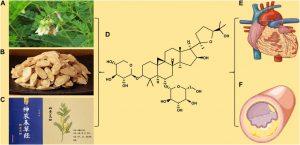The battle against heart failure and hypertrophy, particularly following a myocardial infarction, is one of the most significant challenges in cardiology. A recent study published in The Journal of Cellular Physiology introduces a promising new compound, Astragaloside IV derivative HHQ16, that shows potential in mitigating the damage caused by infarction-induced hypertrophy and heart failure.

Figure 1: (A) Astragalus membranaceus. (B) Astragalus membranaceus. Decoction pieces. (C) Shennong’s Classic of Material Medical and picture of Astragalus membranaceus. (D) Chemical structure of Astragaloside IV. (E) The protection of Astragaloside IV on myocardial disease. (F) The protection of Astragaloside IV on blood vessels.
Astragaloside IV, a compound derived from the medicinal plant Astragalus membranaceus, has long been known for its cardio-protective properties. In this study, HHQ16, a more potent derivative, was tested on animal models and demonstrated impressive results in reducing cardiac hypertrophy and improving heart function. The study found that HHQ16 works by promoting the degradation of stress-related proteins that contribute to the enlargement of the heart muscle, a key driver of heart failure.
The compound also effectively reduced fibrosis, a process where excessive scar tissue forms after heart damage, further contributing to heart dysfunction. By targeting the cellular pathways responsible for these pathological processes, HHQ16 not only prevented further deterioration but also showed signs of reversing some of the damage.
The research provides hope for a new therapeutic option that could be more effective than current treatments in managing post-infarction heart failure. As heart failure remains a leading cause of morbidity and mortality worldwide, the development of treatments like HHQ16 could have a profound impact on patient outcomes.
Journal article: Yang, Chunkun, et al. “Review on the Protective Mechanism of Astragaloside IV against Cardiovascular Diseases.” Frontiers in Pharmacology, vol. 14, 11 May 2023, https://doi.org/10.3389/fphar.2023.1187910. Accessed 6 May 2024.
Summary by Faith Oluwamakinde










